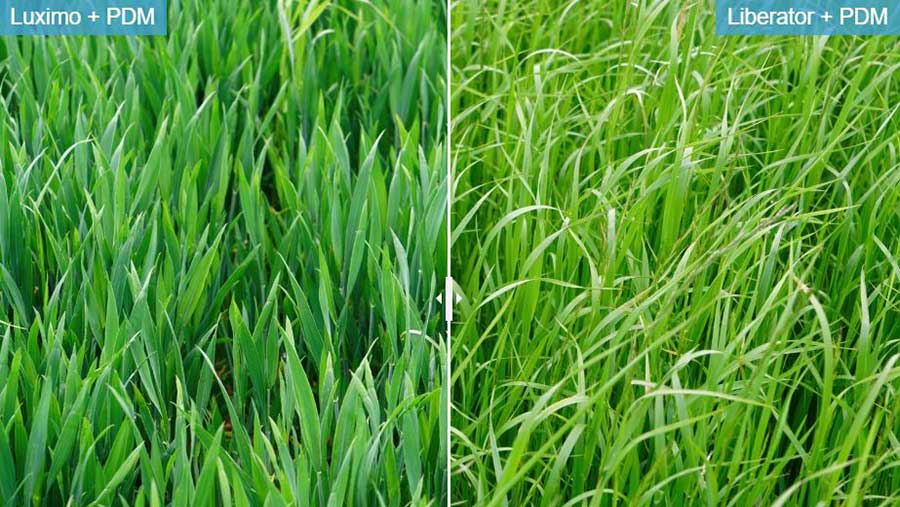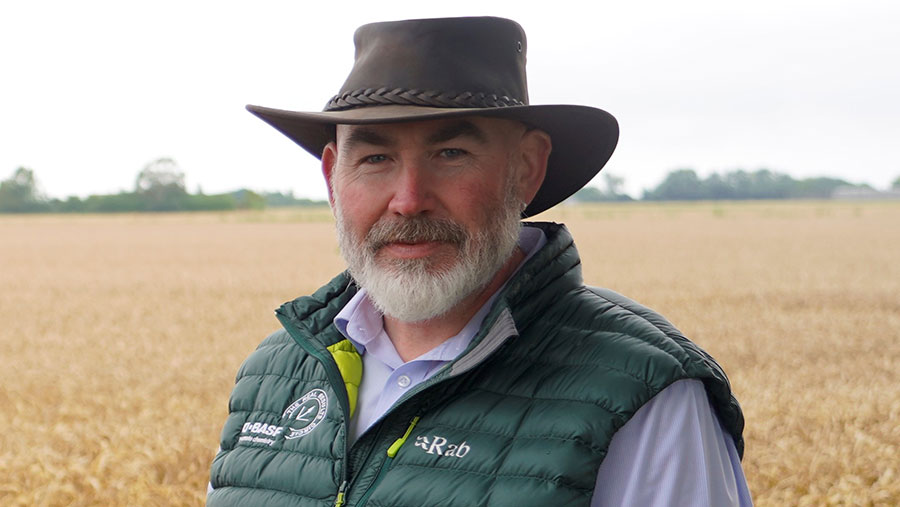Advertiser content
Resetting fields riddled with resistant ryegrass
Provided by
BASF offers renowned and innovative fungicides, herbicides, insecticides and growth regulators for agriculture. Our products and services help farmers increase their yields and optimize the quality of their products.
 © BASF
© BASF When BASF agronomy manager, Colin Mountford-Smith heard about the ryegrass challenge Rob and Peter Barlow were facing, he wanted to help.
The father and son team had recently taken on 160ha infested with the weed some experts say ‘makes blackgrass look like a pussycat’.
Rob and Peter had made great progress with two years of careful management; however, a couple of very stubborn, problem fields remained.
“Back in 2019 a neighbour was retiring and we thought we’d like the opportunity to take on his block of land,” explains Rob. “From looking and talking over the hedge, we knew there was an issue.
“A traditional approach to farming, combined with a history of baling contractors, had enabled ryegrass to get a firm hold and spread prolifically.”

© BASF
Rob and his father farm a total of 260ha of land rented from the Crown’s Bingham Estate in Nottinghamshire. Soil types vary from gravel through to heavy loam.
Since taking on the land, the rotation has been widened, cultivations minimised and well-timed, and Rob pays careful attention to detail in the application of a robust herbicide programme.
Cultural controls change the direction of travel
“We’d love to do spring cropping, but it’s rented land and some of it is so light that we can’t afford risking a spring/summer like we had in 2022,” says Rob.
Instead, Rob and Peter are using a combination of Westwold grass and maize.
“We’ve 1,000 breeding Texel cross ewes and 40 Limousin suckler cows which make use of the grass,” he adds. “After harvest, we drill the grass, and graze it over winter.
“In the spring, a cut of silage is taken before it is sprayed off and the maize crop is sown. It’s working well and controlling the ryegrass but compaction can be an issue,” reflects Rob.
The rotation also includes sugar beet, winter barley as well as winter wheat.

Father and son team, Rob and Peter Barlow © BASF
“There were a few fields that hadn’t been ploughed for five or six years and we’ve been able to both bury the seed and apply Luximo. That’s had great results and really brought the ryegrass back under control.”
Delaying drilling is another tool being deployed across the acreage, though Rob admits there’s often a conflict between getting a crop established and optimising weed control.
“Growing sugar beet and maize means drilling partly depends on when, and in what conditions, previous crops were harvested.
“Being near the River Trent, we can flood and there are lots of hollows which can lay wet. Both add pressure to drill when we can.
“Clean land is drilled first, usually at the very end of September. If the weather was guaranteed for the three weeks that follow, I’d happily leave it.
“It’s always a fine line between getting the crop in when conditions are good for germination and growth, and allowing time for the grass weeds to chit.”
To minimise the risk of spreading seed, the order of fields is the same for spraying and combining. It’s another area where Rob tries to be meticulous.
“All the machinery is blown off and washed down to reduce the risk. We go into the cleanest blocks first and do the dirty ones last.”
Can Luxinum® Plus tip the scale?
On the home farm, the herbicide programme has historically been Liberator (flufenacet and diflufenican) plus Stomp Aqua (pendimethalin) at pre-emergence, followed by Axial Pro (pinoxaden) at post emergence, and it’s worked well.
However, on the new acreage, Rob noted too many survivors.
“Our agronomist, Graham Partington, took samples and sent them off for testing. We weren’t surprised when the results showed RRR resistance,” notes Rob.
It was one of the reasons Rob and Peter accepted Colin’s proposal to trial Luximo® on their worst remaining field.

Light green area in the foreground is the untreated block, surrounded by Luxinum Plus treatments. The larger, light green area in the background is the Liberator treatments. © BASF
“With such a difficult and high population of ryegrass, it was the perfect opportunity to really test Luximo’s performance,” explains Colin.
The crop of Typhoon was drilled across the 24ha field on the 9th October 2022, and herbicide treatments applied on the 11th October.
“In the middle of the field, we applied 0.7 litres Luxinum Plus + 2.0 litres Stomp Aqua pre-emergence, and around it, the ‘farm standard’ of 0.6 litres Liberator + 2.0 litres Stomp Aqua.
“Both blocks were followed up with a spring post-emergence application of 0.8 litres Axial Pro. For benchmarks, there were also three smaller blocks treated with Liberator + pendimethalin, Luxinum Plus + Stomp Aqua, and an untreated block.
“In the autumn, we were a little concerned that we couldn’t find any dead or dying ryegrass in the Luximo plot. Fortunately, the position of the untreated block was reassuring with the ryegrass coming through like hairs on a cat,” says Colin.
At final count on 25th May, the untreated plot had over 670 ryegrass heads/sq m. Of the treated plots, Luxinum®Plus and Stomp® Aqua had the greatest efficacy with just 89 heads/sq m.
The farm standard of Liberator + Stomp®Aqua followed by Axial Pro resulted in 228 heads/sq m.

© BASF
“In the autumn, the control from the Luxinum Plus looked to be around 95%,” says Rob. “But in early spring, we were shocked to see ryegrass appearing.
“Across the UK we’ve seen a second flush in the spring,” explains Colin. “We had that incredibly wet March which prompted a wave of late germination.
“For those that drilled early to mid September and couldn’t make the most of the opportunity to let grass weeds chit and be sprayed off pre-drilling, it’s been a particularly bad problem.”
While Colin suspects the follow up with Axial Pro may have been more effective if it had been applied slightly earlier, Rob notes it seems to have been running out of steam across the farm and is keen to get results from the samples sent for resistance testing this year.
“It didn’t look like the Axial Pro had any effect, but then plants started to be tinged with yellow.
“I’m keen to know whether the seeds are viable – my concern being that they’ll go through the combine and spread to other areas of the farm.”
What’s next?
While it’s been an extremely useful case study for Rob and his father, they intend to put the trial field into a grass ley.
“Ryegrass is such a massive plant that only the most serious chemistry will touch it. We can’t afford to risk it spreading to other areas of the farm,” he says.
Colin adds: “That’s why chemistry is the ‘backstop’ and all cultural controls are still critical.”
Where the ryegrass population isn’t as high as the trial field, Rob intends to continue with the cultural controls already in play. The herbicide programme, however, will undergo significant change.
“We’ll be using a lot more Luximo,” he says. “We’ve got a question mark over the Axial Pro but will wait for the resistance results before dropping it. If there is resistance, it’s a lot of money to spend, and as we’ve not used Avadex before, we’ve options.”
While Rob feels frustrated by the final control of ryegrass this year, Colin is supportive of his approach.

Colin Mountford-Smith © BASF
“Fields that have a history of being ploughed, potentially have a high weed seedbank that you’re working to reduce.
“And in a year like this, when there’s been high spring germination, you can do everything ‘right’ but not get the result you’re looking for, particularly with ryegrass and its prolonged germination. It’s simply due to the weather.”
Luximo has given a big uplift in control compared to the farm standard, thus significantly reducing seed return this year.
“Rob’s strategy of cultural controls combined with the most robust herbicides, and where necessary whole crop removal, is spot on. It is, and will be, a slow burn but in terms of what’s best for this scenario, Rob’s got it right.”
For more information on Luximo, please visit our website.
